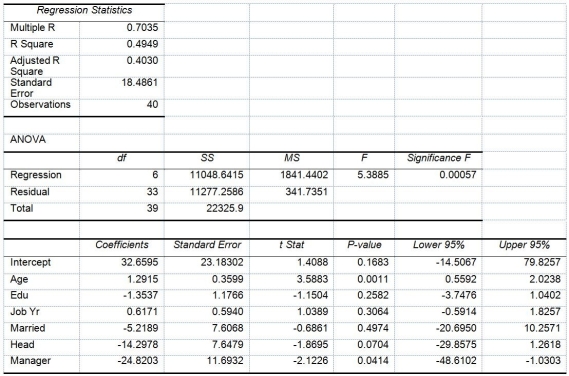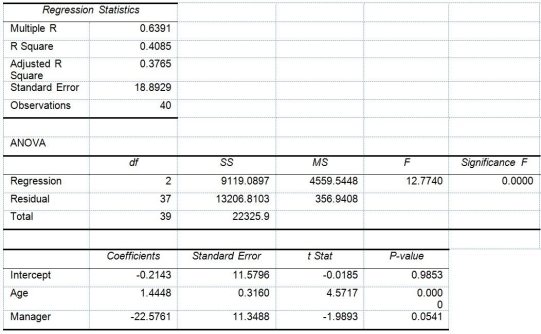TABLE 17-10
Given below are results from the regression analysis where the dependent variable is the number of weeks a worker is unemployed due to a layoff (Unemploy)and the independent variables are the age of the worker (Age),the number of years of education received (Edu),the number of years at the previous job (Job Yr),a dummy variable for marital status (Married: 1 = married,0 = otherwise),a dummy variable for head of household (Head: 1 = yes,0 = no)and a dummy variable for management position (Manager: 1 = yes,0 = no).We shall call this Model 1.The coefficient of partial determination (  )of each of the 6 predictors are,respectively,0.2807,0.0386,0.0317,0.0141,0.0958,and 0.1201.
)of each of the 6 predictors are,respectively,0.2807,0.0386,0.0317,0.0141,0.0958,and 0.1201.  Model 2 is the regression analysis where the dependent variable is Unemploy and the independent variables are Age and Manager.The results of the regression analysis are given below:
Model 2 is the regression analysis where the dependent variable is Unemploy and the independent variables are Age and Manager.The results of the regression analysis are given below: 
-True or False: Referring to Table 17-10,Model 1,the alternative hypothesis H1 : At least one of βj ≠ 0 for j = 1,2,3,4,5,6 implies that the number of weeks a worker is unemployed due to a layoff is related to all of the explanatory variables.
Definitions:
Safety Inventory
Extra inventory held as a buffer against demand variability and supply chain disruptions to prevent stockouts.
Cycle Inventory
The portion of inventory that companies hold to facilitate smooth production and sales operations, fluctuating based on production cycle needs.
Low-Value Product
Products that have a low price point or perceived economic value to the consumer, often resulting in slim profit margins.
High Demand
A situation where the desire and need for a product or service greatly exceeds the available supply within a market.
Q12: Referring to Table 16-15,what are the simple
Q78: Referring to Table 17-9,what is the p-value
Q91: Referring to Table 19-1,if the probability of
Q108: Which of the following is not one
Q115: A Paso Robles wine producer wanted to
Q148: Referring to Table 17-10,Model 1,what are the
Q157: Referring to Table 14-7,the estimate of the
Q158: True or False: Referring to Table 17-8,the
Q215: Referring to Table 14-6,the estimated value of
Q258: True or False: In a particular model,the